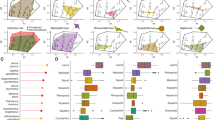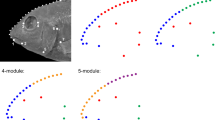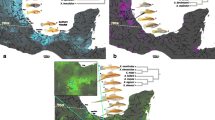Abstract
There has been considerable interest in the directionality of resource specialisation during the diversification of lineages. We developed a quantitative method to investigate habitat specialisation in a radiation of New Zealand triplefin fishes, as habitat use appears to be an important axis of diversification in this marine group. The degree of specialisation in 15 species was calculated by comparing each individual to all other individuals of a species, thus allowing for quantitative distinction between species. Species differed in habitat specialisation, but Bayesian comparative methods found no directional trend in the evolution of resource use. Further analyses showed that specialisation had evolved gradually and was phylogenetically constrained, with most differences between species arising toward the tips of the tree. No correlation between the degree of specialisation and body size was detected in this group, suggesting that habitat specialisation evolved independently of body size. Habitat specialisation does not appear to have been an impediment to ecological diversification in this group. Rather, diversification in these fishes appears to have followed different evolutionary trajectories in habitat specialisation, one in which species have sub-partitioned available resources, and another in which species have expanded their use of resources. These findings support recent studies suggesting that diversification does not necessarily proceed from generalised ancestors to specialised descendants.


Similar content being viewed by others
References
Beu AG (2004) Marine Mollusca of oxygen isotope stages of the last 2 million years in New Zealand. Part 1: Revised generic positions and recognition of warm-water and cool-water migrants. J Roy Soc NZ 34:111–265
Beu AG, Alloway BV, Cooper RA, Crundwell MP, Kamp PJJ, Mildenhall DC, Naish TR, Scott GH, Wilson GS (2004) Pliocene, pleistocene, holocene. In: Cooper RA (ed) The New Zealand geological timescale, vol 22. Institute of Geological and Nuclear Sciences Monograph, Lower Hutt pp 197–228
Brix O, Clements KC, Wells RMG (1999) Haemoglobin components and oxygen transport in relation to habitat distribution in triplefin fishes (Tripterygiidae). J Comp Physiol 169:329–334
Brown JS (1996) Coevolution and community organization in three habitats. Oikos 75:193–206
Caley JM, Munday PL (2003) Growth trade off with habitat specialization. Proc Roy Soc Ser B 270:175–177
Clements KC (2003) Triplefins. In: Andrew N, Francis M (eds) The living reef. The ecology of New Zealand’s rocky reefs. Craig Potton Publishing, Nelson pp 160–167
Clements KC, Jawad LA, Stewart AL (2000) The New Zealand triplefin Grahamina signata (Teleostei; Tripterygiidae): a junior synonym of G. gymnota from Tasmania. J Roy Soc NZ 30:373–384
Crespi BJ, Sandoval CP (2000) Phylogenetic evidence for the evolution of ecological specialization in Tinema walking-sticks. J Evol Biol 13:249–262
Desdevises Y, Morand S, Legendre P (2002) Evolution and determinants of host specificity in the genus Lamellodiscus (Monogenea). Bio J Linn Soc 77:431–443
Elliott JK, Lougheed SC, Bateman B, McPhee LK, Boag PT (1999) Molecular phylogenetic evidence for the evolution of specialization in anemonefishes. Proc Roy Soc Ser B 266:1471–2954
Feary D (2001) Trophic morphology, diet and habitat use of New Zealand triplefins (Family Tripterygiidae). University of Auckland, New Zealand
Feary DA, Clements KC (2006) Habitat use by triplefin fishes (family Tripterygiidae) on rocky reefs in New Zealand. J Fish Biol 69:1031–1046
Freckleton RP, Harvey PH, Pagel M (2002) Phylogenetic analysis and comparative data: a test and review of evidence. Am Nat 160:712–726
Fricke R (1994) Tripterygiid fishes of Australia, New Zealand and the Southwest Pacific Ocean (Teleostei), 1st edn Koeltz Scientific Books, Königstein
Futuyma DJ, Moreno G (1988) The evolution of ecological specialisation. Annu Rev Ecol Syst 19:207–233
Harvey PH, Pagel MD (1991) The comparative method in evolutionary biology. Oxford University Press, Oxford
Hickey AJR, Clements KC (2003) Key metabolic enzymes and muscle structure in triplefin fishes (Tripterygiidae): a phylogenetic comparison. J Comp Physiol B 173:113–123
Hickey AJR, Clements KC (2005) Genome size evolution in New Zealand triplefin fishes. Heredity 7:356–362
Holland B, Moulton V (2003) Consensus networks: a method for visualizing incompatibilities in collections of trees. In: Benson G, Page R (eds) Workshop on algorithms in bioinformatics, vol 2812 of LNBI. Springer, pp 165–176
Huelsenbeck JP, Ronquist F (2001) MRBAYES: Bayesian inference of phylogeny. Bioinformatics (Oxford) 17:754–755
Kelley ST, Farell BD (1998) Is specialization a dead end? The phylogeny of host use in Dendroctonus bark beetles (Scolitidae). Evolution 52:1731–1743
Kneitel JM, Chase JM (2004) Trade-offs in community ecology: linking spatial scales and species coexistence. Ecol Lett 7:69–80
Mayr E (1942) Systematics and the origin of species. Columbia University Press, New York
McPeek MA (1996) Trade-offs, food web structure, and the coexistence of habitat specialists and generalists. Am Nat 148:124–138
Morse GE, Farrell BD (2005) Ecological and evolutionary diversification of the seed beetle genus Stator (Coleoptera: Chrysomelidae: Bruchniae). Evolution 59:1315–1333
Munday PL (2004) Competitive coexistence of coral dwelling fishes: the lottery hypothesis revisited. Ecology 85:623–628
Nagel L, Schluter D (1998) Body size, natural selection, and speciation in sticklebacks. Evolution 52:209–218
Nosil P (2002) Transition rates between specialization and generalization in phytophagous insects. Evolution 56:1701–1706
Nosil P, Mooers AØ (2005) Testing hypotheses about ecological specialization using phylogenetic trees. Evolution 59:2256–2263
Pagel M (1997) Inferring evolutionary processes from phylogenies. Zool Scripta 26:331–348
Pagel M (1999) Inferring the historical patterns of biological evolution. Nature 401:877–884
Pagel M, Meade A (2004) A mixture model for detecting pattern-heterogeneity in gene sequence or character-state data. Syst Biol 53:571–581
Pagel M, Meade A, Barker D (2004) Bayesian estimation of ancestral character states on phylogenies. Syst Biol 53:673–684
Ronquist F, Huelsenbeck JP (2003) MRBAYES 3: Bayesian phylogenetic inference under mixed models. Bioinformatics 19:1572–1574
Rubinoff D, Sperling FAH (2002) Evolution of ecological traits and wing morphology in Hemileuca (Saturniidae) based on a two-gene phylogeny. Mol Phylogenet Evol 25:70–86
Sandoval CP, Nosil P (2005) Counteracting selective regimes and host preference evolution in ecotypes of two species of walking sticks. Evolution 59:2405–2413
Schluter D (2000) The ecology of adaptive radiations, 1st edn Oxford University Press, Oxford
Schluter D, Price TD, Mooers AØ, Ludwig D (1997) Likelihood of ancestor states in adaptive radiation. Evolution 51:1699–1711
Schwarzhans W, Grenfell HR (2002) Fish otolith faunas from Early Nukumaruan sites of Hawke’s Bay and Waipukurau, New Zealand. Proc Taupaki Malacol Soc 3:18–23
Simpson GG (1953) The major features of evolution. Columbia University Press, New York
Stephens PR, Wiens JJ (2003) Ecological diversification and phylogeny of emydid turtles. Bio J Linn Soc 79:577–610
Syms C (1995) Multi-scale analysis of habitat association in a guild of blennioid fishes. Mar Ecol Prog Ser 125:31–43
Wellenreuther M, Clements KD (2007) Reproductive isolation in temperate reef fishes. Mar Biol 152:619–630
Wellenreuther M, Clements KD (in press) Patterns of settlement in five species of triplefin fishes (Family Tripterygiidae). Mar Biol
Wellenreuther M, Barrett PT, Clements KD (2007) Ecological diversification in habitat use in subtidal triplefin fishes (Tripterygiidae). Mar Ecol Prog Ser 330:235–246
Wellenreuther M, Syms C, Clements KD (in press) The role of body size in ecological diversification and reproductive isolation in a sister species pair of triplefin fishes. Evol Ecol
Acknowledgments
We would like to thank Mark Pagel, Andrew Meade, Russell Gray and Alexei Drummond for help with Bayesian methods, and Russell Gray, Steve Heard, Patrik Nosil, Paul Rainey and David Raubenheimer for comments on the manuscript. Vivian Ward produced the colour triplefin illustrations based on line drawings kindly supplied by Clive Roberts at the Museum of New Zealand Te Papa Tongarewa. This work was funded by the Marsden Fund of the New Zealand Royal Society to Kendall D. Clements. and a Top Achiever Doctoral Scholarship from the Tertiary Education Commission (TEC) and a doctoral scholarship from the University of Auckland to Maren Wellenreuther.
Author information
Authors and Affiliations
Corresponding author
Rights and permissions
About this article
Cite this article
Wellenreuther, M., Barrett, P.T. & Clements, K.D. The evolution of habitat specialisation in a group of marine triplefin fishes. Evol Ecol 23, 557–568 (2009). https://doi.org/10.1007/s10682-008-9255-3
Received:
Accepted:
Published:
Issue Date:
DOI: https://doi.org/10.1007/s10682-008-9255-3




